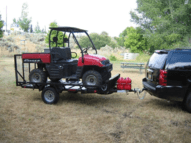
Trailers have made shipping and the transportation of goods and tools easy, but that doesn’t mean there aren’t a few tricks to using them properly. One of the most important of those tricks is to properly distribute the weight of whatever you’re hauling. We here at Factory Outlet Trailers want to help you get the most out of your tools, so we’ve put together a brief guide below on how to distribute cargo in your trailer. To learn more, or to see the trailers we have for sale, contact our store in High River, Alberta, today!
Know Your Limits
All vehicles and trailers have limitations on the weight they can carry. The Gross Vehicle Weight Rating, or GVWR, is the absolute maximum amount a vehicle or trailer can handle, and it includes the weight of:
- The vehicle or trailer itself.
- Anything the vehicle or trailer is towing.
- Any passengers and/or cargo.
- Fuel.
- Aftermarket add-ons and upgrades.
That means that your tow vehicle’s GVWR has to be higher than its weight, the weight of the driver and passengers, the weight of any fuel or cargo, and the weight of the trailer and its cargo. Never overload a vehicle or trailer, since it’s both illegal and incredibly unsafe. If you don’t know the weight of a trailer on its own, bring it to a truck stop or another location with a certified scale.
Distribution Strategies
The primary strategy for loading a trailer with cargo is called the 60/40 rule. You want about 60% of the cargo’s total weight placed in the front of the trailer, which is the end closer to your tow vehicle. The other 40% should be from the middle back. If your trailer has a single axle, that means you want 60% of the weight ahead of the axle with 40% behind.
From side to side, you want the weight to be distributed as evenly as possible, and always make sure to secure it and pack it tight so there’s no shifting while in transit.
Open vs. Enclosed Trailers
Enclosed trailers have an advantage in terms of stacking, since you don’t need to worry about cargo going overboard if a stack tips. You still need to secure them tightly, since shifting weight can still cause problems.
Open trailers are a bit riskier, so keep two rules in mind. First, never load small, light items above the height of the trailer’s sides. Second, use a few more tie-downs than you might think you need to keep things secure.
Transporting Vehicles
When moving a vehicle, make sure to tie it down with the shocks about 50% compressed. Use ratchet straps and D-ring tie-downs to secure the suspension and prevent shifting. The vehicle shouldn’t shift if you try to move it by hand.
We hope this guide helps! For more information, or to see the trailers we have available, contact us at Factory Outlet Trailers. We proudly serve the people of Calgary and Edmonton, Alberta, and the Greater Vancouver Area in British Columbia—let us serve you today!


